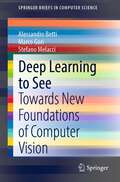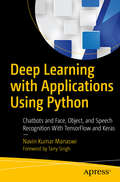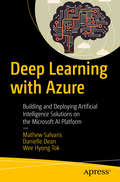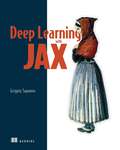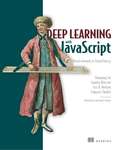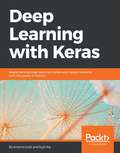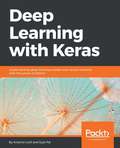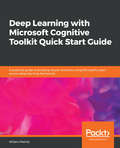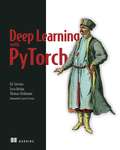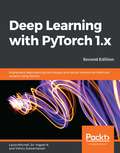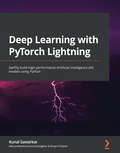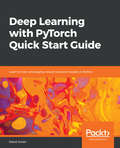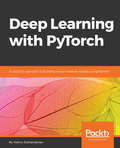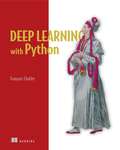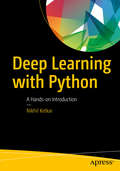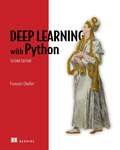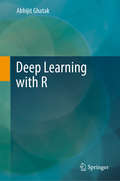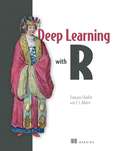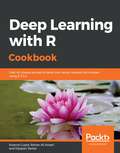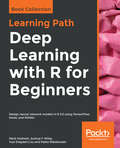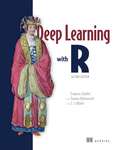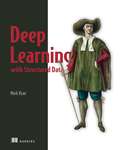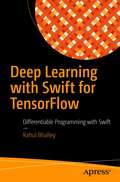- Table View
- List View
Deep Learning to See: Towards New Foundations of Computer Vision (SpringerBriefs in Computer Science)
by Marco Gori Alessandro Betti Stefano MelacciThe remarkable progress in computer vision over the last few years is, by and large, attributed to deep learning, fueled by the availability of huge sets of labeled data, and paired with the explosive growth of the GPU paradigm. While subscribing to this view, this work criticizes the supposed scientific progress in the field, and proposes the investigation of vision within the framework of information-based laws of nature. This work poses fundamental questions about vision that remain far from understood, leading the reader on a journey populated by novel challenges resonating with the foundations of machine learning. The central thesis proposed is that for a deeper understanding of visual computational processes, it is necessary to look beyond the applications of general purpose machine learning algorithms, and focus instead on appropriate learning theories that take into account the spatiotemporal nature of the visual signal.Serving to inspire and stimulate critical reflection and discussion, yet requiring no prior advanced technical knowledge, the text can naturally be paired with classic textbooks on computer vision to better frame the current state of the art, open problems, and novel potential solutions. As such, it will be of great benefit to graduate and advanced undergraduate students in computer science, computational neuroscience, physics, and other related disciplines.
Deep Learning with Applications Using Python: Chatbots And Face, Object, And Speech Recognition With Tensorflow And Keras
by Navin Kumar ManaswiExplore deep learning applications, such as computer vision, speech recognition, and chatbots, using frameworks such as TensorFlow and Keras. This book helps you to ramp up your practical know-how in a short period of time and focuses you on the domain, models, and algorithms required for deep learning applications. Deep Learning with Applications Using Python covers topics such as chatbots, natural language processing, and face and object recognition. The goal is to equip you with the concepts, techniques, and algorithm implementations needed to create programs capable of performing deep learning.This book covers convolutional neural networks, recurrent neural networks, and multilayer perceptrons. It also discusses popular APIs such as IBM Watson, Microsoft Azure, and scikit-learn. What You Will Learn Work with various deep learning frameworks such as TensorFlow, Keras, and scikit-learn.Use face recognition and face detection capabilitiesCreate speech-to-text and text-to-speech functionalityEngage with chatbots using deep learningWho This Book Is ForData scientists and developers who want to adapt and build deep learning applications.
Deep Learning with Azure: Building and Deploying Artificial Intelligence Solutions on the Microsoft AI Platform
by Wee Hyong Tok Mathew Salvaris Danielle DeanGet up-to-speed with Microsoft's AI Platform. Learn to innovate and accelerate with open and powerful tools and services that bring artificial intelligence to every data scientist and developer.Artificial Intelligence (AI) is the new normal. Innovations in deep learning algorithms and hardware are happening at a rapid pace. It is no longer a question of should I build AI into my business, but more about where do I begin and how do I get started with AI?Written by expert data scientists at Microsoft, Deep Learning with the Microsoft AI Platform helps you with the how-to of doing deep learning on Azure and leveraging deep learning to create innovative and intelligent solutions. Benefit from guidance on where to begin your AI adventure, and learn how the cloud provides you with all the tools, infrastructure, and services you need to do AI.What You'll LearnBecome familiar with the tools, infrastructure, and services available for deep learning on Microsoft Azure such as Azure Machine Learning services and Batch AIUse pre-built AI capabilities (Computer Vision, OCR, gender, emotion, landmark detection, and more)Understand the common deep learning models, including convolutional neural networks (CNNs), recurrent neural networks (RNNs), generative adversarial networks (GANs) with sample code and understand how the field is evolvingDiscover the options for training and operationalizing deep learning models on AzureWho This Book Is ForProfessional data scientists who are interested in learning more about deep learning and how to use the Microsoft AI platform. Some experience with Python is helpful.
Deep Learning with Hadoop
by Dipayan DevIf you are a data scientist who wants to learn how to perform deep learning on Hadoop, this is the book for you. Knowledge of the basic machine learning concepts and some understanding of Hadoop is required to make the best use of this book.
Deep Learning with JAX
by Grigory SapunovAccelerate deep learning and other number-intensive tasks with JAX, Google&’s awesome high-performance numerical computing library.The JAX numerical computing library tackles the core performance challenges at the heart of deep learning and other scientific computing tasks. By combining Google&’s Accelerated Linear Algebra platform (XLA) with a hyper-optimized version of NumPy and a variety of other high-performance features, JAX delivers a huge performance boost in low-level computations and transformations. In Deep Learning with JAX you will learn how to: • Use JAX for numerical calculations • Build differentiable models with JAX primitives • Run distributed and parallelized computations with JAX • Use high-level neural network libraries such as Flax • Leverage libraries and modules from the JAX ecosystem Deep Learning with JAX is a hands-on guide to using JAX for deep learning and other mathematically-intensive applications. Google Developer Expert Grigory Sapunov steadily builds your understanding of JAX&’s concepts. The engaging examples introduce the fundamental concepts on which JAX relies and then show you how to apply them to real-world tasks. You&’ll learn how to use JAX&’s ecosystem of high-level libraries and modules, and also how to combine TensorFlow and PyTorch with JAX for data loading and deployment. About the technology Google&’s JAX offers a fresh vision for deep learning. This powerful library gives you fine control over low level processes like gradient calculations, delivering fast and efficient model training and inference, especially on large datasets. JAX has transformed how research scientists approach deep learning. Now boasting a robust ecosystem of tools and libraries, JAX makes evolutionary computations, federated learning, and other performance-sensitive tasks approachable for all types of applications. About the book Deep Learning with JAX teaches you to build effective neural networks with JAX. In this example-rich book, you&’ll discover how JAX&’s unique features help you tackle important deep learning performance challenges, like distributing computations across a cluster of TPUs. You&’ll put the library into action as you create an image classification tool, an image filter application, and other realistic projects. The nicely-annotated code listings demonstrate how JAX&’s functional programming mindset improves composability and parallelization. What's inside • Use JAX for numerical calculations • Build differentiable models with JAX primitives • Run distributed and parallelized computations with JAX • Use high-level neural network libraries such as Flax About the reader For intermediate Python programmers who are familiar with deep learning. About the author Grigory Sapunov holds a Ph.D. in artificial intelligence and is a Google Developer Expert in Machine Learning. The technical editor on this book was Nicholas McGreivy. Table of Contents Part 1 1 When and why to use JAX 2 Your first program in JAX Part 2 3 Working with arrays 4 Calculating gradients 5 Compiling your code 6 Vectorizing your code 7 Parallelizing your computations 8 Using tensor sharding 9 Random numbers in JAX 10 Working with pytrees Part 3 11 Higher-level neural network libraries 12 Other members of the JAX ecosystem A Installing JAX B Using Google Colab C Using Google Cloud TPUs D Experimental parallelization
Deep Learning with JavaScript: Neural networks in TensorFlow.js
by Stanley Bileschi Eric Nielsen Shanqing CaiSummary Deep learning has transformed the fields of computer vision, image processing, and natural language applications. Thanks to TensorFlow.js, now JavaScript developers can build deep learning apps without relying on Python or R. Deep Learning with JavaScript shows developers how they can bring DL technology to the web. Written by the main authors of the TensorFlow library, this new book provides fascinating use cases and in-depth instruction for deep learning apps in JavaScript in your browser or on Node. Foreword by Nikhil Thorat and Daniel Smilkov. About the technology Running deep learning applications in the browser or on Node-based backends opens up exciting possibilities for smart web applications. With the TensorFlow.js library, you build and train deep learning models with JavaScript. Offering uncompromising production-quality scalability, modularity, and responsiveness, TensorFlow.js really shines for its portability. Its models run anywhere JavaScript runs, pushing ML farther up the application stack. About the book In Deep Learning with JavaScript, you&’ll learn to use TensorFlow.js to build deep learning models that run directly in the browser. This fast-paced book, written by Google engineers, is practical, engaging, and easy to follow. Through diverse examples featuring text analysis, speech processing, image recognition, and self-learning game AI, you&’ll master all the basics of deep learning and explore advanced concepts, like retraining existing models for transfer learning and image generation. What's inside - Image and language processing in the browser - Tuning ML models with client-side data - Text and image creation with generative deep learning - Source code samples to test and modify About the reader For JavaScript programmers interested in deep learning. About the author Shanging Cai, Stanley Bileschi and Eric D. Nielsen are software engineers with experience on the Google Brain team, and were crucial to the development of the high-level API of TensorFlow.js. This book is based in part on the classic, Deep Learning with Python by François Chollet. TOC: PART 1 - MOTIVATION AND BASIC CONCEPTS 1 • Deep learning and JavaScript PART 2 - A GENTLE INTRODUCTION TO TENSORFLOW.JS 2 • Getting started: Simple linear regression in TensorFlow.js 3 • Adding nonlinearity: Beyond weighted sums 4 • Recognizing images and sounds using convnets 5 • Transfer learning: Reusing pretrained neural networks PART 3 - ADVANCED DEEP LEARNING WITH TENSORFLOW.JS 6 • Working with data 7 • Visualizing data and models 8 • Underfitting, overfitting, and the universal workflow of machine learning 9 • Deep learning for sequences and text 10 • Generative deep learning 11 • Basics of deep reinforcement learning PART 4 - SUMMARY AND CLOSING WORDS 12 • Testing, optimizing, and deploying models 13 • Summary, conclusions, and beyond
Deep Learning with Keras
by Antonio Gulli Sujit PalGet to grips with the basics of Keras to implement fast and efficient deep-learning models About This Book • Implement various deep-learning algorithms in Keras and see how deep-learning can be used in games • See how various deep-learning models and practical use-cases can be implemented using Keras • A practical, hands-on guide with real-world examples to give you a strong foundation in Keras Who This Book Is For If you are a data scientist with experience in machine learning or an AI programmer with some exposure to neural networks, you will find this book a useful entry point to deep-learning with Keras. A knowledge of Python is required for this book. What You Will Learn • Optimize step-by-step functions on a large neural network using the Backpropagation Algorithm • Fine-tune a neural network to improve the quality of results • Use deep learning for image and audio processing • Use Recursive Neural Tensor Networks (RNTNs) to outperform standard word embedding in special cases • Identify problems for which Recurrent Neural Network (RNN) solutions are suitable • Explore the process required to implement Autoencoders • Evolve a deep neural network using reinforcement learning In Detail This book starts by introducing you to supervised learning algorithms such as simple linear regression, the classical multilayer perceptron and more sophisticated deep convolutional networks. You will also explore image processing with recognition of hand written digit images, classification of images into different categories, and advanced objects recognition with related image annotations. An example of identification of salient points for face detection is also provided. Next you will be introduced to Recurrent Networks, which are optimized for processing sequence data such as text, audio or time series. Following that, you will learn about unsupervised learning algorithms such as Autoencoders and the very popular Generative Adversarial Networks (GAN). You will also explore non-traditional uses of neural networks as Style Transfer. Finally, you will look at Reinforcement Learning and its application to AI game playing, another popular direction of research and application of neural networks. Style and approach This book is an easy-to-follow guide full of examples and real-world applications to help you gain an in-depth understanding of Keras. This book will showcase more than twenty working Deep Neural Networks coded in Python using Keras.
Deep Learning with Keras
by Antonio GulliKeras is a high-level neural network library written in Python, and runs on top of either Theano or TensorFlow. It is a minimal, highly modular framework that runs on both CPU and GPU, and allows you to put your ideas into action in the shortest possible time. This book will help you get started with the basics of Keras, in a highly practical manner.
Deep Learning with Microsoft Cognitive Toolkit Quick Start Guide: A practical guide to building neural networks using Microsoft's open source deep learning framework
by Willem MeintsLearn how to train popular deep learning architectures such as autoencoders, convolutional and recurrent neural networks while discovering how you can use deep learning models in your software applications with Microsoft Cognitive Toolkit Key Features Understand the fundamentals of Microsoft Cognitive Toolkit and set up the development environment Train different types of neural networks using Cognitive Toolkit and deploy it to production Evaluate the performance of your models and improve your deep learning skills Book Description Cognitive Toolkit is a very popular and recently open sourced deep learning toolkit by Microsoft. Cognitive Toolkit is used to train fast and effective deep learning models. This book will be a quick introduction to using Cognitive Toolkit and will teach you how to train and validate different types of neural networks, such as convolutional and recurrent neural networks. This book will help you understand the basics of deep learning. You will learn how to use Microsoft Cognitive Toolkit to build deep learning models and discover what makes this framework unique so that you know when to use it. This book will be a quick, no-nonsense introduction to the library and will teach you how to train different types of neural networks, such as convolutional neural networks, recurrent neural networks, autoencoders, and more, using Cognitive Toolkit. Then we will look at two scenarios in which deep learning can be used to enhance human capabilities. The book will also demonstrate how to evaluate your models' performance to ensure it trains and runs smoothly and gives you the most accurate results. Finally, you will get a short overview of how Cognitive Toolkit fits in to a DevOps environment What you will learn Set up your deep learning environment for the Cognitive Toolkit on Windows and Linux Pre-process and feed your data into neural networks Use neural networks to make effcient predictions and recommendations Train and deploy effcient neural networks such as CNN and RNN Detect problems in your neural network using TensorBoard Integrate Cognitive Toolkit with Azure ML Services for effective deep learning Who this book is for Data Scientists, Machine learning developers, AI developers who wish to train and deploy effective deep learning models using Microsoft CNTK will find this book to be useful. Readers need to have experience in Python or similar object-oriented language like C# or Java.
Deep Learning with PyTorch
by Luca Pietro Antiga Eli Stevens Thomas Viehmann&“We finally have the definitive treatise on PyTorch! It covers the basics and abstractions in great detail. I hope this book becomes your extended reference document.&” —Soumith Chintala, co-creator of PyTorch Key Features Written by PyTorch&’s creator and key contributors Develop deep learning models in a familiar Pythonic way Use PyTorch to build an image classifier for cancer detection Diagnose problems with your neural network and improve training with data augmentation Purchase of the print book includes a free eBook in PDF, Kindle, and ePub formats from Manning Publications.About The Book Every other day we hear about new ways to put deep learning to good use: improved medical imaging, accurate credit card fraud detection, long range weather forecasting, and more. PyTorch puts these superpowers in your hands. Instantly familiar to anyone who knows Python data tools like NumPy and Scikit-learn, PyTorch simplifies deep learning without sacrificing advanced features. It&’s great for building quick models, and it scales smoothly from laptop to enterprise. Deep Learning with PyTorch teaches you to create deep learning and neural network systems with PyTorch. This practical book gets you to work right away building a tumor image classifier from scratch. After covering the basics, you&’ll learn best practices for the entire deep learning pipeline, tackling advanced projects as your PyTorch skills become more sophisticated. All code samples are easy to explore in downloadable Jupyter notebooks. What You Will Learn Understanding deep learning data structures such as tensors and neural networks Best practices for the PyTorch Tensor API, loading data in Python, and visualizing results Implementing modules and loss functions Utilizing pretrained models from PyTorch Hub Methods for training networks with limited inputs Sifting through unreliable results to diagnose and fix problems in your neural network Improve your results with augmented data, better model architecture, and fine tuning This Book Is Written For For Python programmers with an interest in machine learning. No experience with PyTorch or other deep learning frameworks is required. About The Authors Eli Stevens has worked in Silicon Valley for the past 15 years as a software engineer, and the past 7 years as Chief Technical Officer of a startup making medical device software. Luca Antiga is co-founder and CEO of an AI engineering company located in Bergamo, Italy, and a regular contributor to PyTorch. Thomas Viehmann is a Machine Learning and PyTorch speciality trainer and consultant based in Munich, Germany and a PyTorch core developer. Table of Contents PART 1 - CORE PYTORCH 1 Introducing deep learning and the PyTorch Library 2 Pretrained networks 3 It starts with a tensor 4 Real-world data representation using tensors 5 The mechanics of learning 6 Using a neural network to fit the data 7 Telling birds from airplanes: Learning from images 8 Using convolutions to generalize PART 2 - LEARNING FROM IMAGES IN THE REAL WORLD: EARLY DETECTION OF LUNG CANCER 9 Using PyTorch to fight cancer 10 Combining data sources into a unified dataset 11 Training a classification model to detect suspected tumors 12 Improving training with metrics and augmentation 13 Using segmentation to find suspected nodules 14 End-to-end nodule analysis, and where to go next PART 3 - DEPLOYMENT 15 Deploying to production
Deep Learning with PyTorch 1.0 - Second Edition
by Sri. Yogesh K.This book is for data scientists and machine learning engineers who are looking to explore deep learning algorithms using PyTorch 1.x offerings. Those who wish to migrate to PyTorch 1.x will find this book insightful. Some knowledge of machine learning will be helpful. Working knowledge of Python programming is expected.
Deep Learning with PyTorch Lightning: Swiftly build high-performance Artificial Intelligence (AI) models using Python
by Kunal SawarkarBuild, train, deploy, and scale deep learning models quickly and accurately, improving your productivity using the lightweight PyTorch WrapperKey FeaturesBecome well-versed with PyTorch Lightning architecture and learn how it can be implemented in various industry domainsSpeed up your research using PyTorch Lightning by creating new loss functions, networks, and architecturesTrain and build new algorithms for massive data using distributed trainingBook DescriptionPyTorch Lightning lets researchers build their own Deep Learning (DL) models without having to worry about the boilerplate. With the help of this book, you'll be able to maximize productivity for DL projects while ensuring full flexibility from model formulation through to implementation. You'll take a hands-on approach to implementing PyTorch Lightning models to get up to speed in no time.You'll start by learning how to configure PyTorch Lightning on a cloud platform, understand the architectural components, and explore how they are configured to build various industry solutions. Next, you'll build a network and application from scratch and see how you can expand it based on your specific needs, beyond what the framework can provide. The book also demonstrates how to implement out-of-box capabilities to build and train Self-Supervised Learning, semi-supervised learning, and time series models using PyTorch Lightning. As you advance, you'll discover how generative adversarial networks (GANs) work. Finally, you'll work with deployment-ready applications, focusing on faster performance and scaling, model scoring on massive volumes of data, and model debugging.By the end of this PyTorch book, you'll have developed the knowledge and skills necessary to build and deploy your own scalable DL applications using PyTorch Lightning.What you will learnCustomize models that are built for different datasets, model architectures, and optimizersUnderstand how a variety of Deep Learning models from image recognition and time series to GANs, semi-supervised and self-supervised models can be builtUse out-of-the-box model architectures and pre-trained models using transfer learningRun and tune DL models in a multi-GPU environment using mixed-mode precisionsExplore techniques for model scoring on massive workloadsDiscover troubleshooting techniques while debugging DL modelsWho this book is forThis deep learning book is for citizen data scientists and expert data scientists transitioning from other frameworks to PyTorch Lightning. This book will also be useful for deep learning researchers who are just getting started with coding for deep learning models using PyTorch Lightning. Working knowledge of Python programming and an intermediate-level understanding of statistics and deep learning fundamentals is expected.
Deep Learning with PyTorch Quick Start Guide: Learn to train and deploy neural network models in Python
by David JulianIntroduction to deep learning and PyTorch by building a convolutional neural network and recurrent neural network for real-world use cases such as image classification, transfer learning, and natural language processing. Key Features Clear and concise explanations Gives important insights into deep learning models Practical demonstration of key concepts Book Description PyTorch is extremely powerful and yet easy to learn. It provides advanced features, such as supporting multiprocessor, distributed, and parallel computation. This book is an excellent entry point for those wanting to explore deep learning with PyTorch to harness its power. This book will introduce you to the PyTorch deep learning library and teach you how to train deep learning models without any hassle. We will set up the deep learning environment using PyTorch, and then train and deploy different types of deep learning models, such as CNN, RNN, and autoencoders. You will learn how to optimize models by tuning hyperparameters and how to use PyTorch in multiprocessor and distributed environments. We will discuss long short-term memory network (LSTMs) and build a language model to predict text. By the end of this book, you will be familiar with PyTorch's capabilities and be able to utilize the library to train your neural networks with relative ease. What you will learn Set up the deep learning environment using the PyTorch library Learn to build a deep learning model for image classification Use a convolutional neural network for transfer learning Understand to use PyTorch for natural language processing Use a recurrent neural network to classify text Understand how to optimize PyTorch in multiprocessor and distributed environments Train, optimize, and deploy your neural networks for maximum accuracy and performance Learn to deploy production-ready models Who this book is for Developers and Data Scientist familiar with Machine Learning but new to deep learning, or existing practitioners of deep learning who would like to use PyTorch to train their deep learning models will find this book to be useful. Having knowledge of Python programming will be an added advantage, while previous exposure to PyTorch is not needed.
Deep Learning with PyTorch: A practical approach to building neural network models using PyTorch
by Vishnu SubramanianBuild neural network models in text, vision and advanced analytics using PyTorch Key Features Learn PyTorch for implementing cutting-edge deep learning algorithms. Train your neural networks for higher speed and flexibility and learn how to implement them in various scenarios; Cover various advanced neural network architecture such as ResNet, Inception, DenseNet and more with practical examples; Book Description Deep learning powers the most intelligent systems in the world, such as Google Voice, Siri, and Alexa. Advancements in powerful hardware, such as GPUs, software frameworks such as PyTorch, Keras, Tensorflow, and CNTK along with the availability of big data have made it easier to implement solutions to problems in the areas of text, vision, and advanced analytics. This book will get you up and running with one of the most cutting-edge deep learning libraries—PyTorch. PyTorch is grabbing the attention of deep learning researchers and data science professionals due to its accessibility, efficiency and being more native to Python way of development. You'll start off by installing PyTorch, then quickly move on to learn various fundamental blocks that power modern deep learning. You will also learn how to use CNN, RNN, LSTM and other networks to solve real-world problems. This book explains the concepts of various state-of-the-art deep learning architectures, such as ResNet, DenseNet, Inception, and Seq2Seq, without diving deep into the math behind them. You will also learn about GPU computing during the course of the book. You will see how to train a model with PyTorch and dive into complex neural networks such as generative networks for producing text and images. By the end of the book, you'll be able to implement deep learning applications in PyTorch with ease. What you will learn Use PyTorch for GPU-accelerated tensor computations Build custom datasets and data loaders for images and test the models using torchvision and torchtext Build an image classifier by implementing CNN architectures using PyTorch Build systems that do text classification and language modeling using RNN, LSTM, and GRU Learn advanced CNN architectures such as ResNet, Inception, Densenet, and learn how to use them for transfer learning Learn how to mix multiple models for a powerful ensemble model Generate new images using GAN’s and generate artistic images using style transfer Who this book is for This book is for machine learning engineers, data analysts, data scientists interested in deep learning and are looking to explore implementing advanced algorithms in PyTorch. Some knowledge of machine learning is helpful but not a mandatory need. Working knowledge of Python programming is expected.
Deep Learning with Python
by Francois CholletSummaryDeep Learning with Python introduces the field of deep learning using the Python language and the powerful Keras library. Written by Keras creator and Google AI researcher François Chollet, this book builds your understanding through intuitive explanations and practical examples.Purchase of the print book includes a free eBook in PDF, Kindle, and ePub formats from Manning Publications.About the TechnologyMachine learning has made remarkable progress in recent years. We went from near-unusable speech and image recognition, to near-human accuracy. We went from machines that couldn't beat a serious Go player, to defeating a world champion. Behind this progress is deep learning—a combination of engineering advances, best practices, and theory that enables a wealth of previously impossible smart applications.About the BookDeep Learning with Python introduces the field of deep learning using the Python language and the powerful Keras library. Written by Keras creator and Google AI researcher François Chollet, this book builds your understanding through intuitive explanations and practical examples. You'll explore challenging concepts and practice with applications in computer vision, natural-language processing, and generative models. By the time you finish, you'll have the knowledge and hands-on skills to apply deep learning in your own projects. What's InsideDeep learning from first principlesSetting up your own deep-learning environment Image-classification modelsDeep learning for text and sequencesNeural style transfer, text generation, and image generationAbout the ReaderReaders need intermediate Python skills. No previous experience with Keras, TensorFlow, or machine learning is required.About the AuthorFrançois Chollet works on deep learning at Google in Mountain View, CA. He is the creator of the Keras deep-learning library, as well as a contributor to the TensorFlow machine-learning framework. He also does deep-learning research, with a focus on computer vision and the application of machine learning to formal reasoning. His papers have been published at major conferences in the field, including the Conference on Computer Vision and Pattern Recognition (CVPR), the Conference and Workshop on Neural Information Processing Systems (NIPS), the International Conference on Learning Representations (ICLR), and others.Table of ContentsPART 1 - FUNDAMENTALS OF DEEP LEARNING What is deep learning?Before we begin: the mathematical building blocks of neural networks Getting started with neural networksFundamentals of machine learningPART 2 - DEEP LEARNING IN PRACTICEDeep learning for computer visionDeep learning for text and sequencesAdvanced deep-learning best practicesGenerative deep learningConclusionsappendix A - Installing Keras and its dependencies on Ubuntuappendix B - Running Jupyter notebooks on an EC2 GPU instance
Deep Learning with Python
by Nikhil KetkarDiscover the practical aspects of implementing deep-learning solutions using the rich Python ecosystem. This book bridges the gap between the academic state-of-the-art and the industry state-of-the-practice by introducing you to deep learning frameworks such as Keras, Theano, and Caffe. The practicalities of these frameworks is often acquired by practitioners by reading source code, manuals, and posting questions on community forums, which tends to be a slow and a painful process. Deep Learning with Python allows you to ramp up to such practical know-how in a short period of time and focus more on the domain, models, and algorithms.This book briefly covers the mathematical prerequisites and fundamentals of deep learning, making this book a good starting point for software developers who want to get started in deep learning. A brief survey of deep learning architectures is also included.Deep Learning with Python also introduces you to key concepts of automatic differentiation and GPU computation which, while not central to deep learning, are critical when it comes to conducting large scale experiments. What You Will Learn Leverage deep learning frameworks in Python namely, Keras, Theano, and Caffe Gain the fundamentals of deep learning with mathematical prerequisites Discover the practical considerations of large scale experiments Take deep learning models to productionWho This Book Is ForSoftware developers who want to try out deep learning as a practical solution to a particular problem. Software developers in a data science team who want to take deep learning models developed by data scientists to production.
Deep Learning with Python, Second Edition
by Francois CholletUnlock the groundbreaking advances of deep learning with this extensively revised edition of the bestselling original. Learn directly from the creator of Keras and master practical Python deep learning techniques that are easy to apply in the real world.In Deep Learning with Python, Second Edition you will learn: Deep learning from first principles Image classification & image segmentation Timeseries forecasting Text classification and machine translation Text generation, neural style transfer, and image generation Deep Learning with Python has taught thousands of readers how to put the full capabilities of deep learning into action. This extensively revised second edition introduces deep learning using Python and Keras, and is loaded with insights for both novice and experienced ML practitioners. You&’ll learn practical techniques that are easy to apply in the real world, and important theory for perfecting neural networks. Purchase of the print book includes a free eBook in PDF, Kindle, and ePub formats from Manning Publications. About the technology Recent innovations in deep learning unlock exciting new software capabilities like automated language translation, image recognition, and more. Deep learning is becoming essential knowledge for every software developer, and modern tools like Keras and TensorFlow put it within your reach, even if you have no background in mathematics or data science. About the book Deep Learning with Python, Second Edition introduces the field of deep learning using Python and the powerful Keras library. In this new edition, Keras creator François Chollet offers insights for both novice and experienced machine learning practitioners. As you move through this book, you&’ll build your understanding through intuitive explanations, crisp illustrations, and clear examples. You&’ll pick up the skills to start developing deep-learning applications. What's inside Deep learning from first principles Image classification and image segmentation Time series forecasting Text classification and machine translation Text generation, neural style transfer, and image generation About the reader For readers with intermediate Python skills. No previous experience with Keras, TensorFlow, or machine learning is required. About the author François Chollet is a software engineer at Google and creator of the Keras deep-learning library. Table of Contents 1 What is deep learning? 2 The mathematical building blocks of neural networks 3 Introduction to Keras and TensorFlow 4 Getting started with neural networks: Classification and regression 5 Fundamentals of machine learning 6 The universal workflow of machine learning 7 Working with Keras: A deep dive 8 Introduction to deep learning for computer vision 9 Advanced deep learning for computer vision 10 Deep learning for timeseries 11 Deep learning for text 12 Generative deep learning 13 Best practices for the real world 14 Conclusions
Deep Learning with Python: Learn Best Practices of Deep Learning Models with PyTorch
by Jojo Moolayil Nikhil KetkarMaster the practical aspects of implementing deep learning solutions with PyTorch, using a hands-on approach to understanding both theory and practice. This updated edition will prepare you for applying deep learning to real world problems with a sound theoretical foundation and practical know-how with PyTorch, a platform developed by Facebook’s Artificial Intelligence Research Group.You'll start with a perspective on how and why deep learning with PyTorch has emerged as an path-breaking framework with a set of tools and techniques to solve real-world problems. Next, the book will ground you with the mathematical fundamentals of linear algebra, vector calculus, probability and optimization. Having established this foundation, you'll move on to key components and functionality of PyTorch including layers, loss functions and optimization algorithms. You'll also gain an understanding of Graphical Processing Unit (GPU) based computation, which is essential for training deep learning models. All the key architectures in deep learning are covered, including feedforward networks, convolution neural networks, recurrent neural networks, long short-term memory networks, autoencoders and generative adversarial networks. Backed by a number of tricks of the trade for training and optimizing deep learning models, this edition of Deep Learning with Python explains the best practices in taking these models to production with PyTorch.What You'll LearnReview machine learning fundamentals such as overfitting, underfitting, and regularization.Understand deep learning fundamentals such as feed-forward networks, convolution neural networks, recurrent neural networks, automatic differentiation, and stochastic gradient descent.Apply in-depth linear algebra with PyTorchExplore PyTorch fundamentals and its building blocksWork with tuning and optimizing models Who This Book Is ForBeginners with a working knowledge of Python who want to understand Deep Learning in a practical, hands-on manner.
Deep Learning with R
by Abhijit GhatakDeep Learning with R introduces deep learning and neural networks using the R programming language. The book builds on the understanding of the theoretical and mathematical constructs and enables the reader to create applications on computer vision, natural language processing and transfer learning. The book starts with an introduction to machine learning and moves on to describe the basic architecture, different activation functions, forward propagation, cross-entropy loss and backward propagation of a simple neural network. It goes on to create different code segments to construct deep neural networks. It discusses in detail the initialization of network parameters, optimization techniques, and some of the common issues surrounding neural networks such as dealing with NaNs and the vanishing/exploding gradient problem. Advanced variants of multilayered perceptrons namely, convolutional neural networks and sequence models are explained, followed by application to different use cases. The book makes extensive use of the Keras and TensorFlow frameworks.
Deep Learning with R
by J.J. AllaireSummaryDeep Learning with R introduces the world of deep learning using the powerful Keras library and its R language interface. The book builds your understanding of deep learning through intuitive explanations and practical examples. Continue your journey into the world of deep learning with Deep Learning with R in Motion, a practical, hands-on video course available exclusively at Manning.com (www.manning.com/livevideo/deep-learning-with-r-in-motion).Purchase of the print book includes a free eBook in PDF, Kindle, and ePub formats from Manning Publications.About the TechnologyMachine learning has made remarkable progress in recent years. Deep-learning systems now enable previously impossible smart applications, revolutionizing image recognition and natural-language processing, and identifying complex patterns in data. The Keras deep-learning library provides data scientists and developers working in R a state-of-the-art toolset for tackling deep-learning tasks.About the BookDeep Learning with R introduces the world of deep learning using the powerful Keras library and its R language interface. Initially written for Python as Deep Learning with Python by Keras creator and Google AI researcher François Chollet and adapted for R by RStudio founder J. J. Allaire, this book builds your understanding of deep learning through intuitive explanations and practical examples. You'll practice your new skills with R-based applications in computer vision, natural-language processing, and generative models.What's InsideDeep learning from first principlesSetting up your own deep-learning environmentImage classification and generationDeep learning for text and sequencesAbout the ReaderYou'll need intermediate R programming skills. No previous experience with machine learning or deep learning is assumed.About the AuthorsFrançois Chollet is a deep-learning researcher at Google and the author of the Keras library.J.J. Allaire is the founder of RStudio and the author of the R interfaces to TensorFlow and Keras.Table of ContentsPART 1 - FUNDAMENTALS OF DEEP LEARNINGWhat is deep learning?Before we begin: the mathematical building blocks of neural networksGetting started with neural networksFundamentals of machine learningPART 2 - DEEP LEARNING IN PRACTICEDeep learning for computer visionDeep learning for text and sequencesAdvanced deep-learning best practicesGenerative deep learningConclusions
Deep Learning with R Cookbook: Over 45 unique recipes to delve into neural network techniques using R 3.5.x
by Dipayan Sarkar Swarna Gupta Rehan Ali AnsariTackle the complex challenges faced while building end-to-end deep learning models using modern R libraries Key Features Understand the intricacies of R deep learning packages to perform a range of deep learning tasks Implement deep learning techniques and algorithms for real-world use cases Explore various state-of-the-art techniques for fine-tuning neural network models Book Description Deep learning (DL) has evolved in recent years with developments such as generative adversarial networks (GANs), variational autoencoders (VAEs), and deep reinforcement learning. This book will get you up and running with R 3.5.x to help you implement DL techniques. The book starts with the various DL techniques that you can implement in your apps. A unique set of recipes will help you solve binomial and multinomial classification problems, and perform regression and hyperparameter optimization. To help you gain hands-on experience of concepts, the book features recipes for implementing convolutional neural networks (CNNs), recurrent neural networks (RNNs), and Long short-term memory (LSTMs) networks, as well as sequence-to-sequence models and reinforcement learning. You'll then learn about high-performance computation using GPUs, along with learning about parallel computation capabilities in R. Later, you'll explore libraries, such as MXNet, that are designed for GPU computing and state-of-the-art DL. Finally, you'll discover how to solve different problems in NLP, object detection, and action identification, before understanding how to use pre-trained models in DL apps. By the end of this book, you'll have comprehensive knowledge of DL and DL packages, and be able to develop effective solutions for different DL problems. What you will learn Work with different datasets for image classification using CNNs Apply transfer learning to solve complex computer vision problems Use RNNs and their variants such as LSTMs and Gated Recurrent Units (GRUs) for sequence data generation and classification Implement autoencoders for DL tasks such as dimensionality reduction, denoising, and image colorization Build deep generative models to create photorealistic images using GANs and VAEs Use MXNet to accelerate the training of DL models through distributed computing Who this book is for This deep learning book is for data scientists, machine learning practitioners, deep learning researchers and AI enthusiasts who want to learn key tasks in deep learning domains using a recipe-based approach. A strong understanding of machine learning and working knowledge of the R programming language is mandatory.
Deep Learning with R for Beginners: Design neural network models in R 3.5 using TensorFlow, Keras, and MXNet
by Joshua F. Wiley Pablo Maldonado Mark Hodnett Yuxi (Hayden) LiuExplore the world of neural networks by building powerful deep learning models using the R ecosystemKey FeaturesGet to grips with the fundamentals of deep learning and neural networksUse R 3.5 and its libraries and APIs to build deep learning models for computer vision and text processingImplement effective deep learning systems in R with the help of end-to-end projectsBook DescriptionDeep learning finds practical applications in several domains, while R is the preferred language for designing and deploying deep learning models.This Learning Path introduces you to the basics of deep learning and even teaches you to build a neural network model from scratch. As you make your way through the chapters, you’ll explore deep learning libraries and understand how to create deep learning models for a variety of challenges, right from anomaly detection to recommendation systems. The book will then help you cover advanced topics, such as generative adversarial networks (GANs), transfer learning, and large-scale deep learning in the cloud, in addition to model optimization, overfitting, and data augmentation. Through real-world projects, you’ll also get up to speed with training convolutional neural networks (CNNs), recurrent neural networks (RNNs), and long short-term memory networks (LSTMs) in R.By the end of this Learning Path, you’ll be well versed with deep learning and have the skills you need to implement a number of deep learning concepts in your research work or projects.This Learning Path includes content from the following Packt products:R Deep Learning Essentials - Second Edition by Joshua F. Wiley and Mark HodnettR Deep Learning Projects by Yuxi (Hayden) Liu and Pablo MaldonadoWhat you will learnImplement credit card fraud detection with autoencodersTrain neural networks to perform handwritten digit recognition using MXNetReconstruct images using variational autoencodersExplore the applications of autoencoder neural networks in clustering and dimensionality reductionCreate natural language processing (NLP) models using Keras and TensorFlow in RPrevent models from overfitting the data to improve generalizabilityBuild shallow neural network prediction modelsWho this book is forThis Learning Path is for aspiring data scientists, data analysts, machine learning developers, and deep learning enthusiasts who are well versed in machine learning concepts and are looking to explore the deep learning paradigm using R. A fundamental understanding of R programming and familiarity with the basic concepts of deep learning are necessary to get the most out of this Learning Path.
Deep Learning with R, Second Edition
by Francois Chollet Tomasz Kalinowski J. J. AllaireDeep learning from the ground up using R and the powerful Keras library!In Deep Learning with R, Second Edition you will learn: Deep learning from first principles Image classification and image segmentation Time series forecasting Text classification and machine translation Text generation, neural style transfer, and image generation Deep Learning with R, Second Edition shows you how to put deep learning into action. It&’s based on the revised new edition of François Chollet&’s bestselling Deep Learning with Python. All code and examples have been expertly translated to the R language by Tomasz Kalinowski, who maintains the Keras and Tensorflow R packages at RStudio. Novices and experienced ML practitioners will love the expert insights, practical techniques, and important theory for building neural networks. About the technology Deep learning has become essential knowledge for data scientists, researchers, and software developers. The R language APIs for Keras and TensorFlow put deep learning within reach for all R users, even if they have no experience with advanced machine learning or neural networks. This book shows you how to get started on core DL tasks like computer vision, natural language processing, and more using R. About the book Deep Learning with R, Second Edition is a hands-on guide to deep learning using the R language. As you move through this book, you&’ll quickly lock in the foundational ideas of deep learning. The intuitive explanations, crisp illustrations, and clear examples guide you through core DL skills like image processing and text manipulation, and even advanced features like transformers. This revised and expanded new edition is adapted from Deep Learning with Python, Second Edition by François Chollet, the creator of the Keras library. What's inside Image classification and image segmentation Time series forecasting Text classification and machine translation Text generation, neural style transfer, and image generation About the reader For readers with intermediate R skills. No previous experience with Keras, TensorFlow, or deep learning is required. About the author François Chollet is a software engineer at Google and creator of Keras. Tomasz Kalinowski is a software engineer at RStudio and maintainer of the Keras and Tensorflow R packages. J.J. Allaire is the founder of RStudio, and the author of the first edition of this book. Table of Contents 1 What is deep learning? 2 The mathematical building blocks of neural networks 3 Introduction to Keras and TensorFlow 4 Getting started with neural networks: Classification and regression 5 Fundamentals of machine learning 6 The universal workflow of machine learning 7 Working with Keras: A deep dive 8 Introduction to deep learning for computer vision 9 Advanced deep learning for computer vision 10 Deep learning for time series 11 Deep learning for text 12 Generative deep learning 13 Best practices for the real world 14 Conclusions
Deep Learning with Structured Data
by Mark RyanDeep Learning with Structured Data teaches you powerful data analysis techniques for tabular data and relational databases.Summary Deep learning offers the potential to identify complex patterns and relationships hidden in data of all sorts. Deep Learning with Structured Data shows you how to apply powerful deep learning analysis techniques to the kind of structured, tabular data you'll find in the relational databases that real-world businesses depend on. Filled with practical, relevant applications, this book teaches you how deep learning can augment your existing machine learning and business intelligence systems. Purchase of the print book includes a free eBook in PDF, Kindle, and ePub formats from Manning Publications. About the technology Here&’s a dirty secret: Half of the time in most data science projects is spent cleaning and preparing data. But there&’s a better way: Deep learning techniques optimized for tabular data and relational databases deliver insights and analysis without requiring intense feature engineering. Learn the skills to unlock deep learning performance with much less data filtering, validating, and scrubbing. About the book Deep Learning with Structured Data teaches you powerful data analysis techniques for tabular data and relational databases. Get started using a dataset based on the Toronto transit system. As you work through the book, you&’ll learn how easy it is to set up tabular data for deep learning, while solving crucial production concerns like deployment and performance monitoring. What's inside When and where to use deep learning The architecture of a Keras deep learning model Training, deploying, and maintaining models Measuring performance About the reader For readers with intermediate Python and machine learning skills. About the author Mark Ryan is a Data Science Manager at Intact Insurance. He holds a Master's degree in Computer Science from the University of Toronto. Table of Contents 1 Why deep learning with structured data? 2 Introduction to the example problem and Pandas dataframes 3 Preparing the data, part 1: Exploring and cleansing the data 4 Preparing the data, part 2: Transforming the data 5 Preparing and building the model 6 Training the model and running experiments 7 More experiments with the trained model 8 Deploying the model 9 Recommended next steps
Deep Learning with Swift for TensorFlow: Differentiable Programming with Swift
by Rahul BhalleyDiscover more insight about deep learning algorithms with Swift for TensorFlow. The Swift language was designed by Apple for optimized performance and development whereas TensorFlow library was designed by Google for advanced machine learning research. Swift for TensorFlow is a combination of both with support for modern hardware accelerators and more. This book covers the deep learning concepts from fundamentals to advanced research. It also introduces the Swift language for beginners in programming. This book is well suited for newcomers and experts in programming and deep learning alike. After reading this book you should be able to program various state-of-the-art deep learning algorithms yourself. The book covers foundational concepts of machine learning. It also introduces the mathematics required to understand deep learning. Swift language is introduced such that it allows beginners and researchers to understand programming and easily transit to Swift for TensorFlow, respectively. You will understand the nuts and bolts of building and training neural networks, and build advanced algorithms. What You’ll Learn • Understand deep learning concepts • Program various deep learning algorithms • Run the algorithms in cloud Who This Book Is For • Newcomers to programming and/or deep learning, and experienced developers. • Experienced deep learning practitioners and researchers who desire to work in user space instead of library space with a same programming language without compromising the speed
